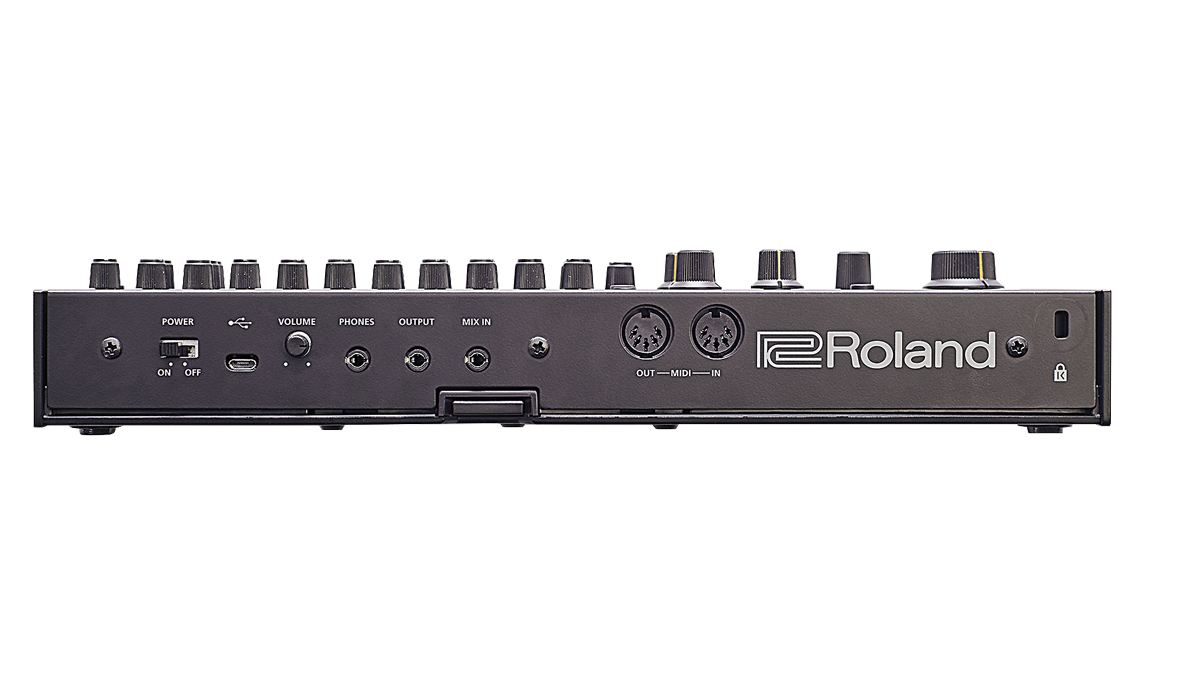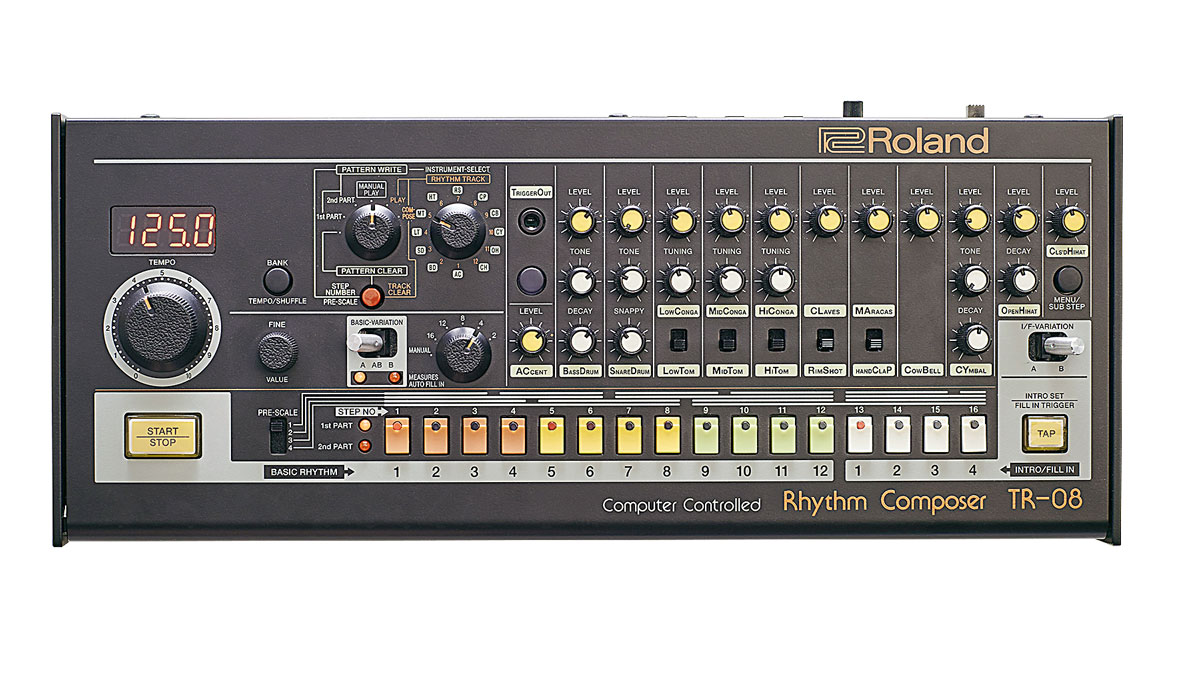MusicRadar Verdict
A decent-sounding digital resurrection of a classic beatbox, although extra outs and more adjustable sonics would be a welcome addition to this new model.
Pros
- +
Less noisy than the original 808, and can go entirely digital via USB.
- +
Front panel trigger is separately programmable from other sounds.
Cons
- -
We’d like to see more detailed sound editing.
- -
Additional outputs only available via USB when connected to a computer. Requires another audio driver and DAW.
MusicRadar's got your back
There seems to be no stopping Roland’s enthusiasm, in the shape of its Boutique series, for releasing diminutive digital clones of past glories.
All these come with the same footprint, attempting to recreate the sound, look and interactivity of the originals. The chosen front panel size makes all of them fall into the somewhat bijou ‘miniature’ category.
The latest in line for Roland’s analogue-to-digital distillation process is the TR-808 Rhythm Composer (or drum machine in more generic parlance). The original TR-808 arrived at an important time in the development of electronic music technology.
From the late 1970s, and into the early 1980s, integrated circuits (silicon chips) became increasingly affordable and accessible. This, combined with developments in computer processing and digital memory, allowed a whole host of interesting instruments to come to market.
The TR-808 took advantage of some of these developments to create a drum machine that was capable of creating multi-pattern rhythm tracks for full songs, whilst providing the user with some timbral adjustment of the sounds and options for syncing to other gear.
However, in sonic terms, the TR-808 employed techniques for sound generation that had been used by Roland and others since the 1960s. These were distinctly electronic, but the 808 was used to very good effect on some classic tracks, meaning that it gaining it a revered status.

With cult status comes much baggage about how best to recreate the original magic (whether in analogue or digital clones), so let’s get things straight from the start there is no such thing as ‘a perfect 808 recreation’.
The TR-808, like so much analogue gear, sits on a rather fluid sonic continuum. Even at the time, component differences meant that each 808 left the factory sounding somewhat different. Dive into the service manual and you’ll find that - like the TR-909 - the 808 underwent a few design tweaks (most noticeable in the pitching of earlier units’ snare and hats).
However, this is only the start, as numerous changes take place as components age. And if you thought that delving into the innards of an 808 would allow you to easily tweak your beloved unit back to its factory state, you are much mistaken. There are only four internal trimmers that alter the sound, so unless you want to get into some hardcore modding, beyond the front panel knobs you’re stuck with what you’re given.
In order to prepare for this review we took a mid-run TR-808, calibrated it as per the original service manual, and programmed a quick test pattern. First impressions were favourable, though as expected, there were noticeable differences - the most obvious being those related to the pitch and timbre of the hats and cymbal.
In fact, the waveforms generated by six basic Schmitt Trigger oscillators, and their relative filter and pitch tunings (of which only two can be trimmed internally) are at the core of each 808’s sound, as they are used by the Hats, Cymbal and Cowbell. Other smaller differences could be found in the pitches of some sounds (not all of which can be adjusted on either unit), and a measurable brightness to the TR-08. See the box below for more on all of this.
It’s easy to just focus on the ‘authenticity’ aspects of the TR-08, but it is much more of a 21st Century machine than the original in quite few ways beyond its DSP-driven sound engine.
Here’s just how the TR-08 stacks up against our TR-808. KICK - pretty close, though amplitude envelopes followed subtly different curves.
SNARE - Can’t be retuned on the TR-08. Mine was a few semitones higher, but otherwise largely similar.
TOMS - TR-08 had more bite and a slightly more pronounced noise component.
CONGAS - The TR-08 Mid Conga had more pronounced harmonic content.
RIM SHOT/CLAVE/MARACAS - all broadly similar (perhaps due in part to their simplicity).
CLAP - there was a noticeably different shape to each of these (the 808 exhibiting more am).
COWBELL - 808 was fuller, with TR-08 sound almost compressed, with its pronounced attack.
HI HATS/CYMBAL - Tuning the TR-08 changes filter frequency, but not underlying harmonics.
Although the programming system follows broadly similar lines to the original, you now have the ability to add sub-step beats, create random patterns and dial in some swing - all useful features. This is all aided somewhat by the four-character LED display, which also facilitates the selection and editing of a number of menu-based parameters.
As on the TR-09, compression can be applied individually to the Kick and Snare, whilst Tuning and Decay is available for some sounds (with the ability to select a long decay version of the Kick for those Miami Bass lovers out there).
This area also takes care of panning and routing via the analogue stereo out and USB audio channels, though a decent OLED screen might have widened the scope for future additions and less menu diving.
MIDI is also well-served, with the ability to send and receive a decent range of CC messages and ability to trigger ‘shared’ sound slots (toms, congas etc) remotely.
As on the TR-09, compression can be applied individually to the Kick and Snare, whilst Tuning and Decay is available for some sounds
We enjoyed the TR-08, though it would have been great to have a few pre-configured sonic variants, custom artist settings, or some extra ‘modding’ tools - all pretty easy to achieve in the digital universe. Another missed trick is the ability to use the Accent trigger pulse as a sound source - an old-school ploy which should have been integrated into the internal mixer.
We have some reservations about the pricing too - as with the TR-09, this sits just the wrong side of the £300 mark, considering it’s a digital recreation rather than an analogue groovebox. Despite these niggles though, if you’re in the market for a hardware 808 clone, the TR-08 is definitely worth a listen.
"I said, “What’s that?” and they said, “It’s what Quincy Jones and Bruce Swedien use on all the Michael Jackson records": Steve Levine reminisces on 50 years in the industry and where it’s heading next
“Excels at unique modulated timbres, atonal drones and microtonal sequences that reinvent themselves each time you dare to touch the synth”: Soma Laboratories Lyra-4 review
“I used everything I knew about music”: How Green Day exceeded expectations with their most ambitious song










